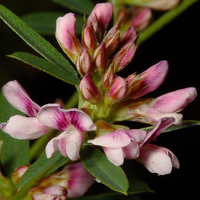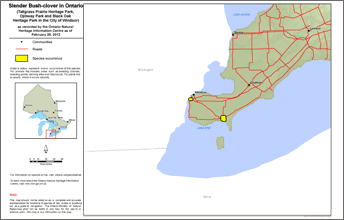Slender bush-clover
Scientific name: Lespedeza virginica

Cover photo credit: Allen Woodliffe
Status
Endangered
“Endangered” means the species lives in the wild in Ontario but is facing imminent extinction or extirpation.
Date added to the Species at Risk in Ontario List
The Slender bush-clover was already assessed as June 30, 2008. It was re assessed as endangered in 2013.
Read the report (PDF)
What it looks like
Slender bush-clover is a flowering plant belonging to the pea family that can grow up to 1.5 metres high. It has compound leaves composed of three leaflets that are narrow and elongated.
This plant produces two types of flower: showy pinkish-purple pea-like flowers and tiny inconspicuous flowers without petals. The showy flowers are usually in crowded clusters on the upper part of the stem.
The inconspicuous flowers are cleistogamous, meaning they can produce fertile seeds without having been pollinated by insects. The fruits are thin brown seedpods, roughly round in shape and four to seven millimetres long.
Where it lives
In Ontario, Slender bush-clover grows on dry, sandy soil in tallgrass prairies. This plant does not do well in the shade and can be harmed by other plants that compete for light and space.
The open and sunny prairie habitat it prefers, depends on natural disturbances, such as fire and drought, which naturally remove many unwanted trees and shrubs.
Where it’s been found in Ontario
In Ontario, Slender bush-clover is found only in Essex County, the most southwesterly county in the province. A total of approximately 180 plants were counted at the two locations in 1997.
View a larger version of this map (PDF)
What threatens it
One of the main threats to Slender bush-clover is the establishment of trees and shrubs that shade-out these sun-loving plants through a process called “natural succession”.
Invasive plants that compete for space are also a serious problem. Incidental destruction of plants from pedestrian and ATV traffic is another threat.
Action we are taking
Endangered Species and their general habitat are automatically protected.
Recovery strategy
A recovery strategy advises the ministry on ways to ensure healthy numbers of the species return to Ontario.
Read the executive summary (November 22, 2013)
Read the recovery strategy (November 22, 2013)
Government response statement
A government response statement outlines the actions the government intends to take or support to help recover the species.
Read the government response statement (December 15, 2014)
Review of progress
A review of progress made toward protecting and recovering a species is required no later than the time specified in the species’ government response statement, or not later than five years after the government response statement is published if no time is specified.
Read the report on progress towards the protection and recovery of 16 species at risk, including Slender bush-clover (Lespedeza virginica) (2019).
Habitat protection
General Habitat Protection - June 30, 2008
What you can do
Report a sighting
Report a sighting of an endangered animal or plant to the Natural Heritage Information Centre. Photographs with specific locations or mapping coordinates are always helpful.
Volunteer
Volunteer with your local nature club or provincial park to participate in surveys or stewardship work focused on species at risk.
Be a good steward
- private land owners have a very important role to play in species recovery; if you find Slender bush-clover on your land, you may be eligible for stewardship programs that support the protection and recovery of species at risk and their habitats
- pollinators, such as bees, are in steep decline across the globe and they play a key role in the survival of many of Ontario’s rare plants; for information on how you can help scientists monitor pollinator populations in Ontario visit Seeds of Diversity
- invasive species seriously threaten many of Ontario’s species at risk; to learn what you can do to help reduce the threat of invasive species, visit:
- Slender bush-clover and many other species at risk depend on healthy grassland prairies, a rare habitat in Ontario; learn more about these habitats, the species that depend on them, and what you can do to help
Report illegal activity
Report any illegal activity related to plants and wildlife to
Quick facts
- one of the most important nutrients that a plant needs is nitrogen; the roots of Slender bush-clover contain special bacteria that can create nitrogen, which allows this plant to grow in soils that are too nitrogen-deficient for most other plants; unfortunately, many invasive plants such as White sweet-clover also have this adaptation, allowing them to compete with Ontario’s native plants
- Slender bush-clover is eaten by a variety of insects and supports the larvae of several butterfly species
- fire plays an important roll in maintaining the prairie habitat of Slender bush-clover; fire naturally removes trees, shrubs and many invasive plants that would otherwise shade-out prairie plants
